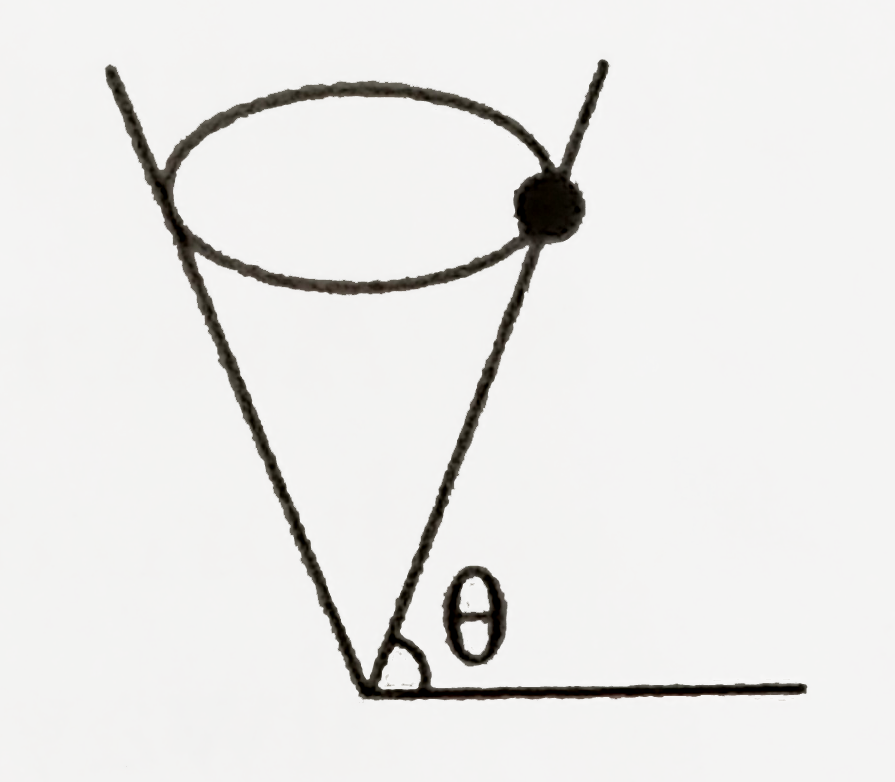Assertion: A particle of mass m takes uniform horizontal circular motion inside a smooth funnel as shown. Normal reaction in this case is not mgcosθ .

Reason: Acceleration of particle is not along the surface of funnel.
If both Assertion and Reason are true and the Reason is correct explanation of the Assertion.
If both Assertion and Reason are true but Reason is not the correct explanation of Assertion.
If Assertion is true, true but the Reason is false.
If Assertion is false but the Reason is true.
The correct Answer is:A

Ncosθ=mg
⇒N=mgsecθ
and Nsinθ=mv2R
Topper's Solved these Questions
- CIRCULAR MOTIONBOOK - DC PANDEY ENGLISHCHAPTER - CIRCULAR MOTIONEXERCISE - Level 1 Objective
14 Videos
- CIRCULAR MOTIONBOOK - DC PANDEY ENGLISHCHAPTER - CIRCULAR MOTIONEXERCISE - Level 1 Subjective
13 Videos
- CIRCULAR MOTIONBOOK - DC PANDEY ENGLISHCHAPTER - CIRCULAR MOTIONEXERCISE - Exercise 10.3
4 Videos
- CENTRE OF MASS, LINEAR MOMENTUM AND COLLISIONBOOK - DC PANDEY ENGLISHCHAPTER - CENTRE OF MASS, LINEAR MOMENTUM AND COLLISIONEXERCISE - Level 2 Subjective
21 Videos
- COMMUNICATION SYSTEMBOOK - DC PANDEY ENGLISHCHAPTER - COMMUNICATION SYSTEMEXERCISE - Only One Option is Correct
27 Videos
Similar Questions
Assertion A small block of mass m is rotating in a circle inside a smooth cone as shown in figure. In this case the normal reaction,
N≠mg cosθ
Reason In this case, acceleraion of the block is not along the surface of cone. It is horizontal.

View SolutionA particle of mass 'm' is moving in horizontal circle inside a smooth inverted fixed vertical cone above height 'h' from apex. Angle of cone is θ, then

View Solution
Knowledge Check
A particle of mass m is initially situated at point P inside a hemispherical surface of radius r as shown in the figure. A horizontal acceleration of magnitude ao is suddenly produced acceleration on the particle in the horizontal direction. If gravitational acceleration is neglected, then time taken by the particle to touch the sphere again is
 A√4rsinαaoB√4rtanαaoC√4rcosαaoDNone of these
A√4rsinαaoB√4rtanαaoC√4rcosαaoDNone of these
Is the acceleration of particle in uniform circular motion constant or vartiable?
View SolutionA particle of mass m is doing horizontal circular motion with the help of a string (conical pendulum) as shown in the figure. If speed of the particle is constant then,

View SolutionA particle of mass m moves along a horizontal circle of radius R such that normal acceleration of particle varies with time as an=kt2. where k is a constant.
Tangential force on particle at t s is
View SolutionA particle of mass m moves along a horizontal circle of radius R such that normal acceleration of particle varies with time as an=kt2. where k is a constant.
Total force on particle at time t s is
View SolutionA particle of mass m moves along a horizontal circle of radius R such that normal acceleration of particle varies with time as an=kt2. where k is a constant.
Power developed by total at time T is
View SolutionA Particle of mass 'M' moves in a uniform circular path of radius 'r' with a constant speed 'v' then its centripetal acceleration is .
View SolutionA paticle of mass m is executing uniform circular motion on a path of radius r. If p is the magnitude of its linear momentum, then the radial force acting on the particle is
View Solution
